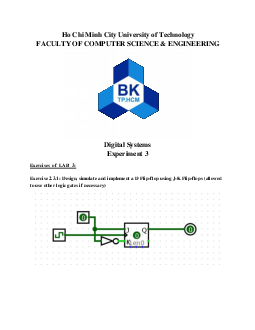



Preview text:
lOMoARcPSD| 36667950
VIETNAM NATIONAL UNIVERSITY HO CHI MINH
UNIVERSITY OF TECHNOLOGY
DEPARTMENT OF COMPUTER SCIENCE AND ENGINEERING LAB 2
SUBJECT: DIGITAL SYSTEM lOMoARcPSD| 36667950 Exercises 2.3 Exercises
2.3.1 Measurement Propagation Delay
In digital circuits, the propagation delay, or gate delay, is the length of time which
starts when the input to a logic gate becomes stable and valid to change, to the
time that the output of that logic gate is stable and valid to change. Often on
manufacturers' datasheets this refers to the time required for the output to reach
50% of its final output level when the input changes to 50% of its final input level.
1) Select ICs: 7432 (Quad OR) and 7408 (Quad AND)
2) Design logic circuitsTruth table for OR gate: A B X = A + B 0 0 0 0 1 1 1 0 1 1 1 1
Truth table for AND gate: A B X = A . B 0 0 0 0 1 0 1 0 0 1 1 1 Simulate in Logisim: lOMoARcPSD| 36667950 - Led 4-U1: 3 3) Implement circuits AND Gates: 7408s (U1) OR Gates: 7432s (U1) - 5V-U1: 14 - GND-U1: 7 - 5V-U1:14 - SW1-U1: 13 - GND-U1: 7 - SW2-U1: 12 - SW1-U1: 13 - SW3-U1: 10 - SW2-U1:12 - SW4-U1: 9 - SW3-U1: 10 - SW5-U1: 1 - SW4-U1:9 - SW6-U1: 2 - SW5-U1:1 - SW7-U1: 4 - SW6-U1: 2 - SW8-U1: 5 - SW7-U1: 4 - Led 1-U1: 11 - SW8-U1: 5 - Led 2-U1: 8 - Led 1-U1: 11 - Led 3-U1: 6 - Led 2-U1: 8 - Led 4-U1: 3 - Led 3-U1: 6
2.3.2 Signal Edge Detection (Edge Detector Circuit)
Signal edge detection is a technique widely used in embedded software, model
based development and electronics. A signal edge is defined as the transition of
the signal from a high state to a low state or vice-versa. There are two popular types of edge detection: -
Rising edge: when the input signal is transitioning from a low state to a high state. lOMoARcPSD| 36667950 -
Falling edge: when the input signal is transitioning from a high state to a low state.
